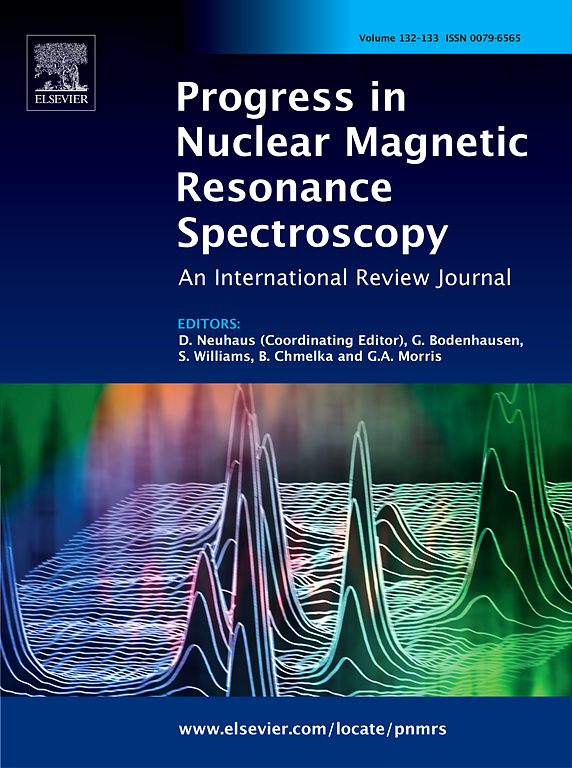Principles and Progress in ultrafast 2D spatiotemporally encoded MRI
IF 8.2
2区 化学
Q2 CHEMISTRY, PHYSICAL
Progress in Nuclear Magnetic Resonance Spectroscopy
Pub Date : 2025-02-13
DOI:10.1016/j.pnmrs.2025.101559
引用次数: 0
Abstract
Magnetic resonance imaging (MRI) is an indispensable tool used in both the lab and the clinic. Part of the strength of MRI comes from its ability to deliver anatomical information highlighted with different types of contrasts, including functional and diffusion-oriented acquisitions that are often incompatible with normal, multi-shot scans. For these problems, Nobel-award-winning techniques such as Echo Planar Imaging (EPI) have been essential in opening a manifold of new applications. EPI, however, has challenges when dealing with sharp changes in magnetic susceptibility, including those arising in the presence of air/tissue or air/fat interfaces, from non-ferromagnetic metal implants, as well when the main magnetic field cannot be shimmed to achieve the desired degree of homogeneity, as often is the case in systems built using permanent magnets. Among the techniques being proposed to deal with this kind of problem is spatiotemporally-encoded (SPEN) MRI. The present review focuses on the principles of this technique, with an emphasis on: i) explaining SPEN's resilience to field inhomogeneities, on the basis of expanded bandwidth considerations vis-à-vis EPI; ii) “the good, the bad and the ugly” associated with the undersampling that SPEN usually has to carry out when employing expanded bandwidths; iii) recent developments in data processing algorithms seeking to alleviate the “bad and the ugly” part of these experiments by formulating SPEN image reconstruction as an optimization problem, and then relying on compressed sensing and parallel imaging concepts to achieve improved image quality; and iv) the incorporation of experimental improvements including scan interleaving, simultaneous multi-banding and multi-echo elements, to keep in line with advancements in other areas of fast MRI. The strengths and weaknesses of these data sampling and processing strategies are assessed, and examples of their leverage in functional, but foremost diffusion-weighted, imaging applications, are presented.

超快二维时空编码MRI的原理与进展
磁共振成像(MRI)是实验室和临床不可缺少的工具。MRI的部分优势来自于其提供不同类型对比突出的解剖信息的能力,包括功能和扩散导向的获取,这通常与正常的多次扫描不兼容。对于这些问题,诸如回声平面成像(EPI)等获得诺贝尔奖的技术在开辟多种新应用方面至关重要。然而,EPI在处理磁化率的急剧变化时面临挑战,包括在非铁磁性金属植入物中存在空气/组织或空气/脂肪界面时产生的变化,以及当主磁场无法达到所需的均匀度时,如使用永磁体构建的系统中经常出现的情况。目前提出的处理这类问题的技术之一是时空编码(SPEN) MRI。目前的审查侧重于该技术的原则,重点是:i)解释SPEN的弹性场非均匀性,在扩大带宽的基础上考虑-à-vis EPI;ii)当使用扩展带宽时,SPEN通常必须进行与欠采样相关的“好、坏和丑”;iii)数据处理算法的最新发展,旨在通过将SPEN图像重建制定为优化问题,然后依靠压缩感知和并行成像概念来改善图像质量,从而减轻这些实验的“坏和丑”部分;iv)结合实验改进,包括扫描交错,同时多带和多回波元素,以保持与其他快速MRI领域的进展一致。评估了这些数据采样和处理策略的优点和缺点,并介绍了它们在功能上的杠杆作用,但最重要的是扩散加权成像应用的例子。
本文章由计算机程序翻译,如有差异,请以英文原文为准。
求助全文
约1分钟内获得全文
求助全文
来源期刊
CiteScore
14.30
自引率
8.20%
发文量
12
审稿时长
62 days
期刊介绍:
Progress in Nuclear Magnetic Resonance Spectroscopy publishes review papers describing research related to the theory and application of NMR spectroscopy. This technique is widely applied in chemistry, physics, biochemistry and materials science, and also in many areas of biology and medicine. The journal publishes review articles covering applications in all of these and in related subjects, as well as in-depth treatments of the fundamental theory of and instrumental developments in NMR spectroscopy.

 求助内容:
求助内容: 应助结果提醒方式:
应助结果提醒方式:


